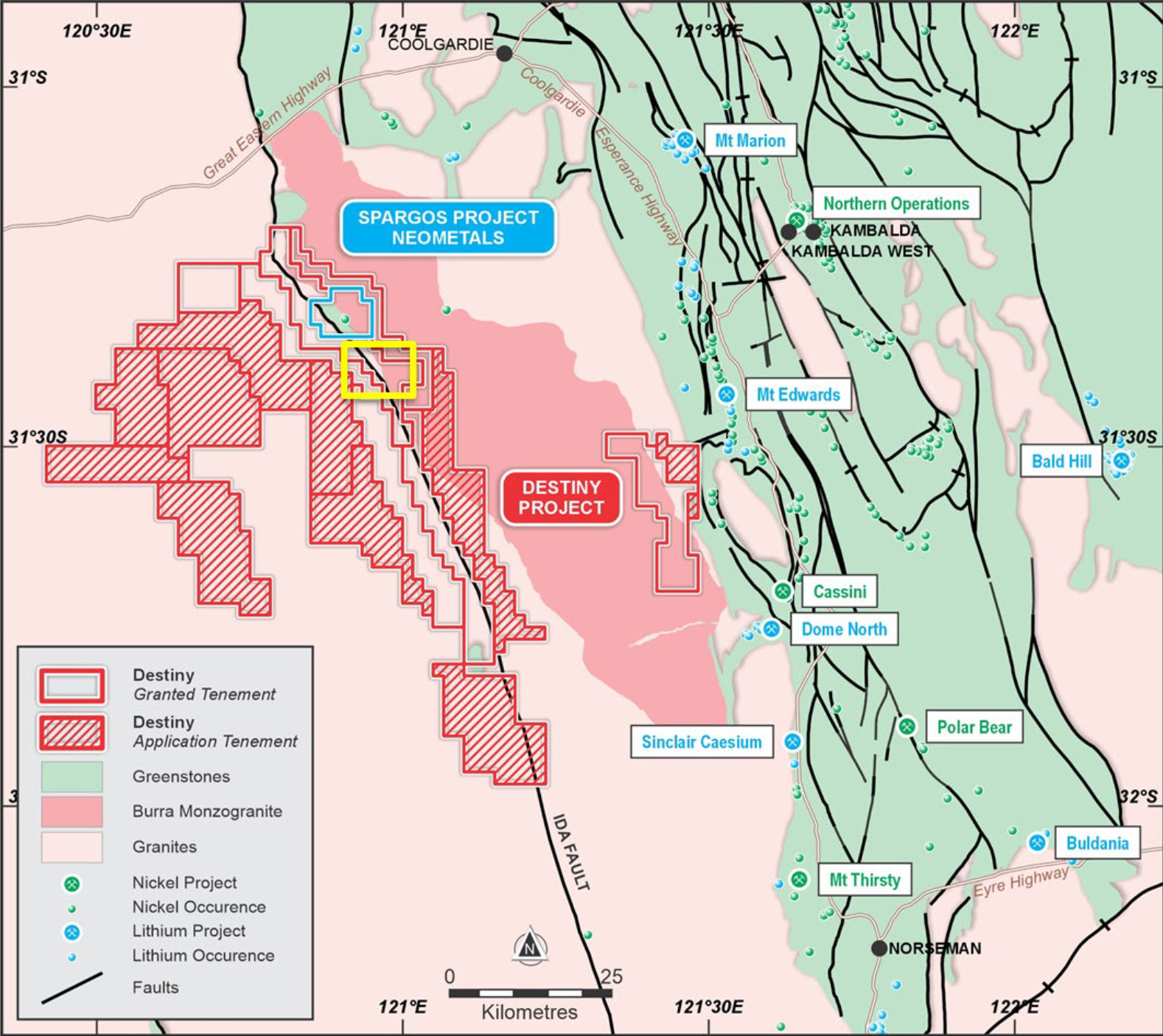Date with Destiny: St George makes high-grade rare earths discovery in WA

The project, previously called Woolgangie, was acquired earlier this year. Pic: via Getty Images.
- St George Mining hits up to 5,125ppm TREO at Destiny project in WA
- The project sits on 90km+ of the Ida Fault, host to multiple major mineral deposits
- Follow-up drilling planned to test both rare earths and lithium potential
Special Report: St George Mining has hit up to 5,125ppm Total Rare Earth Oxide (TREO) hosted in a near-surface clay zone during maiden drilling at its Destiny project in WA.
The company acquired the project, originally called Woolgangie, earlier this year with tenure comprising a dominant landholding of 3,350km2 in the Coolgardie Mineral Field and +90km of the Ida Fault.
The Ida Fault is a major crustal boundary which controls multiple major mineral deposits including Delta Lithium’s (ASX:DLI) 12.7Mt Mt Ida project and Liontown Resources’ (ASX:LTR) $895m Kathleen Valley mine which is set to come online next year.
On-the-ground exploration activities commenced in September to follow up thick intercepts which hit up to 470ppm REE, encountered in historical drilling in 2010 by Mincor Resources (ASX:MCR) while it was exploring for nickel sulphides.
The initial focus was on the Central, Western and the Eastern tenements, with the Eastern tenements in particular part of an established region that hosts Mineral Resources’ (ASX:MIN) Mt Marion mine and the Pioneer Dome deposit being acquired by Develop (ASX:DVP).
Now St George Mining (ASX:SGQ) has announced the discovery of a significant clay-hosted REE system at the Destiny project.
High-value magnetic rare earths
Maiden drilling comprised 61 aircore (AC) holes for 2,145m covering 30km2 and included a 7km stretch of the Ida Fault.
The program intersected thick zones of high-grade TREO with notable assays including:
- 8m at 1,673ppm TREO, 342ppm MREO from 24m (WGAC0001);
- 30m at 1,885ppm TREO, 399ppm MREO from 20m, including 6m at 3,578ppm TREO, 755ppm MREO from 32m, and including 2m at 5,125ppm TREO, 1,199ppm MREO from 32m (WGAC0026);
- 42m at 1,832ppm TREO, 351ppm MREO from 12m, including 14m at 2,622ppm TREO, 515ppm MREO from 38m (WGAC0030); and
- 29m at 1,042ppm TREO, 200ppm MREO from 14m (WGAC0100).
Heavy Rare Earth Oxides (HREO) comprise 17% of TREO based on the average across all drill holes and high-value Magnetic Rare Earth Oxides (MREO) – such as neodymium and praseodymium needed for the permanent magnets used in electric vehicle motors – comprise a high percentage of TREO, at 19% on average across all drill holes.
SGQ is confident that, with a multi-decade transition to clean energy underway, demand for MREO is expected to increase strongly over coming years and underscore a need to secure local sources of supply.
“These are ground-breaking results for the company in our first-ever drill program at the Destiny project, with high-grade rare earths confirmed along a 7km-long strike of the Ida Fault,” SGQ executive chairman John Prineas said.
“The high grades returned in the assays are very exciting.
“Together with the scale of the prospective geology – which may extend for more than 70km – the potential of the project is impressive.
“Importantly, the assays show a high proportion of sought-after magnetic rare earths – a feature that could be a huge value driver for the project.”

Following up what could be a substantial REE system
Initial observations suggest that the Ida Fault may be a trap site for accumulation of mineralisation, and the company believes this may prove to be a valuable targeting tool for further drilling.
With only 7km of the Destiny project’s 90km prospective horizon along the Ida Fault tested by drilling, the exploration upside and scale of the REE potential are substantial, SGQ says.
A follow-up drill program is now being designed to further define the clay-hosted REE mineralisation and to test for potential extensions along strike from known mineralisation and include infill drilling of high-grade intercepts.
This program is planned to commence in early 2024.
“The flat-lying nature of the REE mineralisation and the host clay zone allow for a fairly simple follow-up exploration program of drilling along strike as well as infill drilling,” Prineas said.
“We want to be back drilling at Destiny early in 2024 to unlock the full potential of this exciting REE discovery.”
“The REE project is complementary to our lithium and nickel assets, enhancing St George’s position as a high-impact explorer of multiple battery metals in the Tier 1 jurisdiction of Western Australia.”
Lithium exploration also underway
In addition to the REE prospectivity at the Destiny project, SGQ is advancing hard-rock lithium exploration targets, with field mapping and sampling of pegmatites underway in an area adjacent to the Spargos project of Neometals (ASX: NMT), where spodumene occurrences have been reported.
“The Destiny project covers 3,350km2 and takes in more than 90km of the Ida fault – a regional scale crustal shear zone that is gaining increased interest as a control on major mineral deposits in Western Australia,” Prineas said.
“The Kathleen Valley lithium deposit (156Mt at 1.4% Li2O) of Liontown and the Mt Ida lithium deposit (14.6Mt at 1.2% Li2O) of Delta Lithium are two major lithium deposits associated with the Ida Fault.
“We are excited to control more than 90km of the Ida Fault at our Destiny project – and another 30km strike at our Mt Alexander project – with advanced targets for lithium, rare earths, nickel and copper.”
SGQ will work up the schedule for a maiden lithium drill program at Destiny once the initial field work has been completed and results analysed.
This article was developed in collaboration with St George Mining, a Stockhead advertiser at the time of publishing.
This article does not constitute financial product advice. You should consider obtaining independent advice before making any financial decisions.
Related Topics

UNLOCK INSIGHTS
Discover the untold stories of emerging ASX stocks.
Daily news and expert analysis, it's free to subscribe.
By proceeding, you confirm you understand that we handle personal information in accordance with our Privacy Policy.








